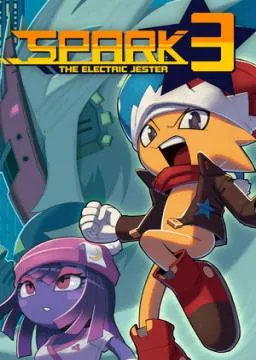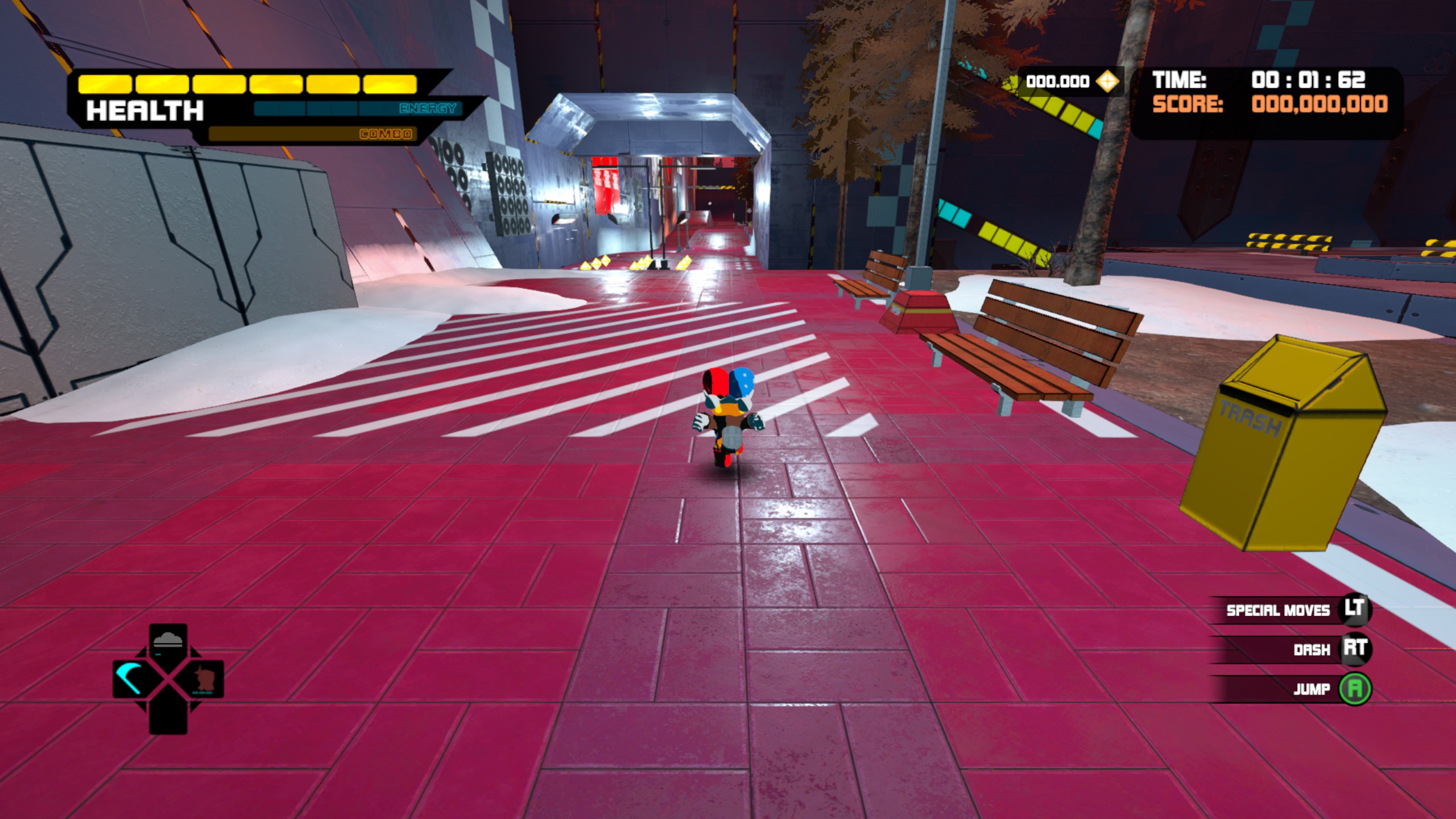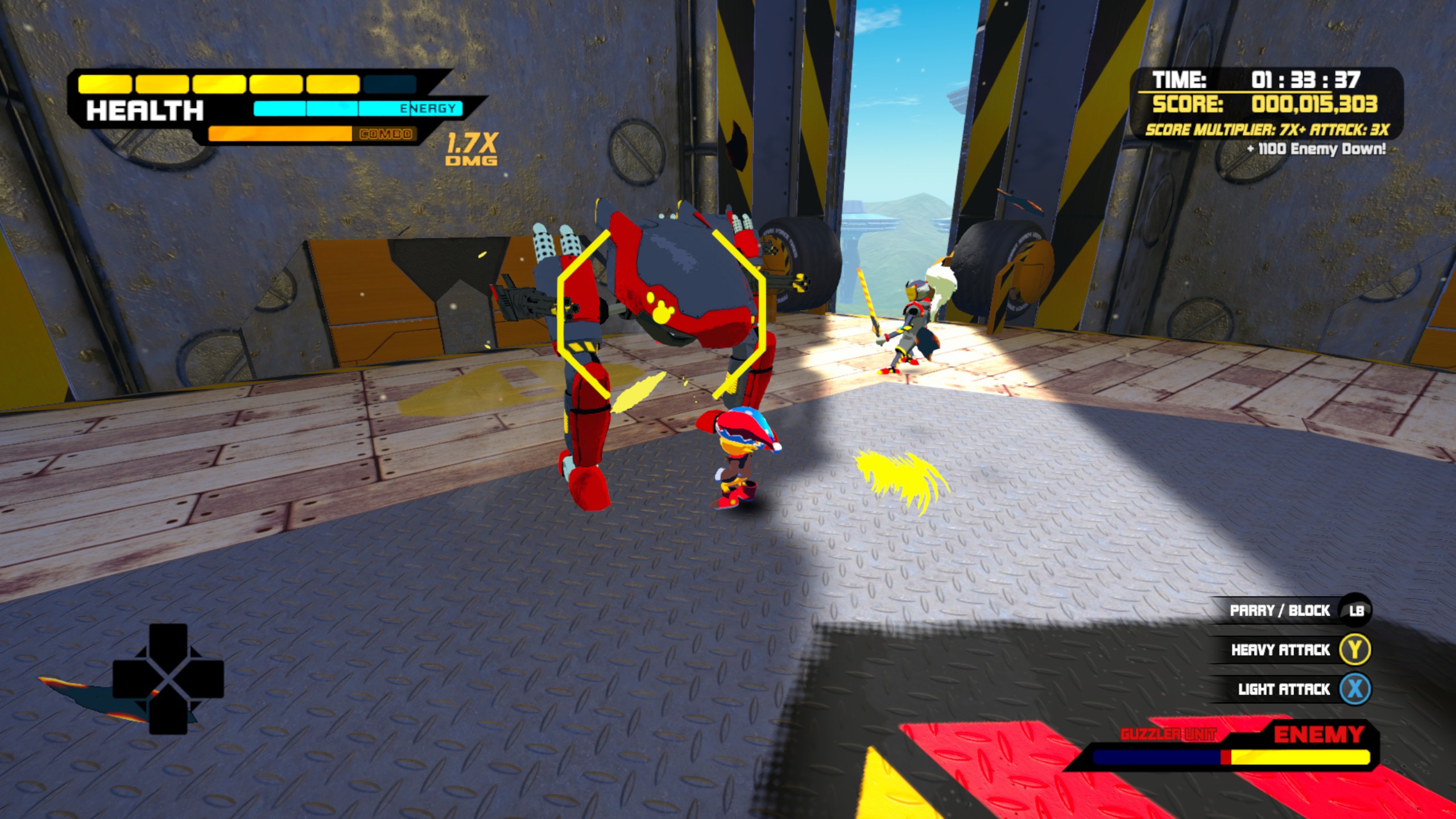Search
[{{{type}}}] {{{reason}}}
{{/data.error.root_cause}}{{{_source.title}}} {{#_source.showPrice}} {{{_source.displayPrice}}} {{/_source.showPrice}}
{{#_source.showLink}} {{/_source.showLink}} {{#_source.showDate}}{{{_source.displayDate}}}
{{/_source.showDate}}{{{_source.description}}}
{{#_source.additionalInfo}}{{#_source.additionalFields}} {{#title}} {{{label}}}: {{{title}}} {{/title}} {{/_source.additionalFields}}
{{/_source.additionalInfo}}- Details
- Category: Computer
- By Cinque Pierre
- Hits: 2165
Spark the Electric Jester 3 (PC)

Spark the Electric Jester 3
Developed By: Feperd Games
Published By: Feperd Games
Released: August 14, 2022
Available: Windows
Genre: Action; Platformer
ESRB Rating: Not rated
Number of Players: Single player
Price: $24.99
Seeing an indie developer improve their craft over the years of developing games is something I've learned to enjoy from my time as a reviewer. Sole Brazilian developer Felipe Ribeiro Daneluz of Feperd Games has been working on the Spark the Electric Jester series for over five years now. With everything he has experienced, now comes Spark the Electric Jester 3. Like its predecessor, it is a 3D action-platformer inspired by the Sonic Adventure series. While Spark 2 is definitely a good game, it did feel more like a tech demo of sorts—for things to come. Spark 3 takes nearly all of the aspects of Spark 2 (and even some of Spark 1) and polishes it to such a degree that it manages to be amazing. Spark 3 feels like what Feperd Games envisioned his 3D game to be like, and now has the skills to do so. Returning character Spark finds out that after his absence, Fark seems to have taken over the planet and seized control of the internet with his new team, the Fark Force. Spark is rather confused about this whole debacle because Spark and Fark left on good terms in Spark 1, and he even heard that Fark defeated Freom once and for all in Spark 2. Rather than wait an obnoxiously long time to withdraw some money from the bank, he decides to venture forth to understand why everything is happening. Spark 3’s story is a direct continuation of Spark 2’s with many returning characters such as Flint, Float, and Dr. Armstrong. You don’t have to play Spark 2 (or even Spark 1) as there is a recap of events after the first level. There are a lot of callbacks to Spark 2 so you’ll miss out on those if you didn’t play it. Stage progression has one main level (known as areas) and a half-dozen or so branching sublevels that expand on the theme that the main level is based on. While the main levels can vary in length, and many of them can be completed in less than two minutes, you’re given the incentive to explore them with the newly introduced exploration medals. Just like the other games, levels will reward you with score and speed medals depending on how fast you complete them or how much score you obtain. All of these are mutually exclusive so you can focus on specific medals each time. A lot of praise goes to the level design because when you think you found an unintended method to go through the level, turns out that there was an exploration medal or a huge collection of bits (Spark 3's ingame currency used to purchase upgrades) in the path. The stages are expansive and have even greater set pieces than Spark 2, sometimes transitioning mid-level. The forest level starts burning up halfway through, and there’s the planetarium level that changes from a space background to a blank white room. The level in the city even has you go downtown where protests are taking place and you get to use the crowd as leverage to reach higher ground. Sublevels at times even introduce gimmicks or use mechanics that you won’t see in the main levels. Set pieces were always strong in the series, but I believe they hit the peak in Spark 3.

Strong Points: Refinement of the 3D space that Spark 2 introduced; final segment is insane (in a good way); combat system has seen a much-needed improvement
Weak Points: Fall damage mechanic is completely unnecessary; vehicle sections can feel too gimmicky
Moral Warnings: Violence against robots; some mild language such as “crap”, “hell”, and “d*mn”; crude humor during one cutscene
There is a bit more refinement in how Spark controls in Spark 3 compared to Fark in Spark 2. Movement is smoother, chaining homing attacks between enemies is more natural (with your jump and dash refreshing after each successful hit), and there is no more of that “smooth turning” that made segments in Spark 2 pretty frustrating. Grinding on the rails in levels even has a dedicated action so you don’t accidentally plummet to your death. A few changes such as Spark’s version of parrying/blocking bring him to a standstill, which can take some time to get used to if you're playing this directly after Spark 2, but there is a reason for this. Combat has seen numerous improvements. In Spark 2, the growing pains of transitioning from a 2D entry to a 3D one were felt. So Spark 2 ended up having moments where the game made you “look” awesome, but you didn’t exactly “feel” awesome all the time as you can effiectly button mash your entire way through. There were also moments when weak enemies that can be killed with one attack mixed in with enemies that took more punishment making for a strange sense of pacing. Spark 3 fully commits to the combat this time around, with things such as an improved combat system and more variety in enemy attacks to the point where the difficulty can be adjusted depending on platforming or combat. The weak enemies and strong enemies are also separated, leading to improved pacing. Even if you still don’t like the combat system, you can crank combat difficulty all the way down so you don’t have to put much, if any, thought into it. Even so, combat in Spark 3 feels closer to other action games such as Devil May Cry and Bayonetta where there are true combo strings between your attacks, and the ability to learn additional moves with the bits (currency) you earn through the stages. There is no ranking system like the latter two games, but like Devil May Cry (and Bayonetta to a lesser extent), you are encouraged to mix up your smorgasbord of moves instead of spamming the same move over and over again. Even after buying certain moves, you have the option to disable them, so in a way you can tailor your moveset to your liking instead of accidentally performing the wrong moves. Combat has a better flow to it overall and I found myself enjoying it—even looking forward to it. Enemies and bosses also have different attacks such as yellow-coded attacks being unable to block and green-coded attacks signaling a grab or another special move so you’re just not running into an enemy’s face all the time and thoughtlessly blocking away. On one hand, Jester Powers are basically entirely absent in exchange for different playable characters. But on the other hand, since the flow of combat is improved and expanded on, the lack of Jester Powers in Spark 3 doesn’t feel like it’s missing part of its identity. Plus you get to see the whole “Electric Jester” aspect of the series with them missing. In regards to graphics, the levels themselves look as good as ever, and the character models have seen polish as well. Opting for a more colorful palette and use of cel-shading, characters have changed for the better. Spark himself even sports a brown leather jacket, giving him a more distinct visual design. The music mostly consists of techno and rock beats with some vocal tracks here and there.

Higher is better
(10/10 is perfect)
Game Score - 88%
Gameplay 17/20
Graphics 8/10
Sound 9/10
Stability 5/5
Controls 5/5
Morality Score - 81%
Violence 6.5/10
Language 6/10
Sexual Content 9/10
Occult/Supernatural 9/10
Cultural/Moral/Ethical 10/10
Spark 3 has a lot of good about it, but not every choice made was the best it could have been. There are a few vehicle segments that take place in a car and a bi-copter. While I did enjoy the bi-copter, the physics of the car did feel weird to me—and Spark 3 starts inside of the car, so it didn’t exactly leave the best first impression. However, if you're good enough at speed and platforming, using vehicles in the vehicle segments is optional. I can still understand why they are there as they do grant some variety. What I don’t understand on the other hand is why fall damage exists in Spark 3. Neither Spark 1 nor 2 have this mechanic. You’ll take some damage if you fall a certain distance or outright die if you fall too far. There are some ways to mitigate this such as dashing or double jumping, but only two levels throughout the entire game take advantage of this (and barely at that). All other times, it just serves as an annoyance. While I do feel that boss fights are an improvement from Spark 2, the fact that one boss is the same guy four times and he barely changes throughout all four times feels a bit disappointing. And I don't know if it's just me, but I can't seem to find any options menu at all to adjust settings. Fortunately, Spark 3 is very stable for my 3060ti and ran at a consistent 144 FPS. Strangely, there are also a couple of quality-of-life adjustments that are missing from Spark 2, such as the option to see gold and platinum time/score requirements for stages after completing the game once. What I enjoyed the most about Spark 3 are the final segments as there is a massive gauntlet of a level called Utopia Shelter that goes on from anywhere from 20 to 30 minutes, incorporating many of the mechanics you were learning throughout the adventure, while also incorporating new gimmicks. This level even uses the medals you were earning throughout the stages in a way that had me nervous the entire way through. And while I didn’t have too much trouble in said stage, it’s a substantial difficulty spike compared to the rest of the game. The game does graciously notify you of this before entering, which is nice for the not-so-mechanically skilled. While the story was never a highlight of the Spark series, the climax of the plot goes in such an insane direction that I found it enjoyable in a way that I would have never seen coming. Morality is the same as the other entries in terms of violence, although a little bit lower in other apsects. You’re still fighting against robots and you’re still destroying them. Some mild forms of language returned such as “crap”, “hell”, and “d*mn” were used a few times, all within the final segments. One slightly questionable “Jester Power” is the Reaper Jester, which has a ghost-like appearance. Some crude humor exists in a cutscene where Spark comes across returning character Float, who has a drastically different design than Spark 2. As she asks him some questions, he looks directly at her chest and asks “First of all, what are those?” while she opts to not answer said question. It all came together in Spark the Electric Jester 3. All that work on fan games and true original games did culminate into this entry, which I feel is Feperd Games's best creation yet. I did enjoy all the Spark games, but Spark 3 was the only one that I wanted more after I was done with it. It’s the longest in the series for a standard playthrough, with it taking anywhere between four and five hours to complete. After the credits roll, you unlock all of Spark 2’s stages to play, two additional characters, and a new game plus feature. After completing the Spark 2 levels, two more combat-focused levels unlock with one level being an endless wave of enemies that address certain issues with the combat in the story such as enemy aggression and variety. Then there are all the medals that you may have failed to get the first time around. With how levels are designed, replayability is not only encouraged, but expected. Great experiences can sometimes come from the most unsuspecting of places, and fans of the Sonic Adventure games and fast-placed platformers in general should put Spark 3 on their radar.








